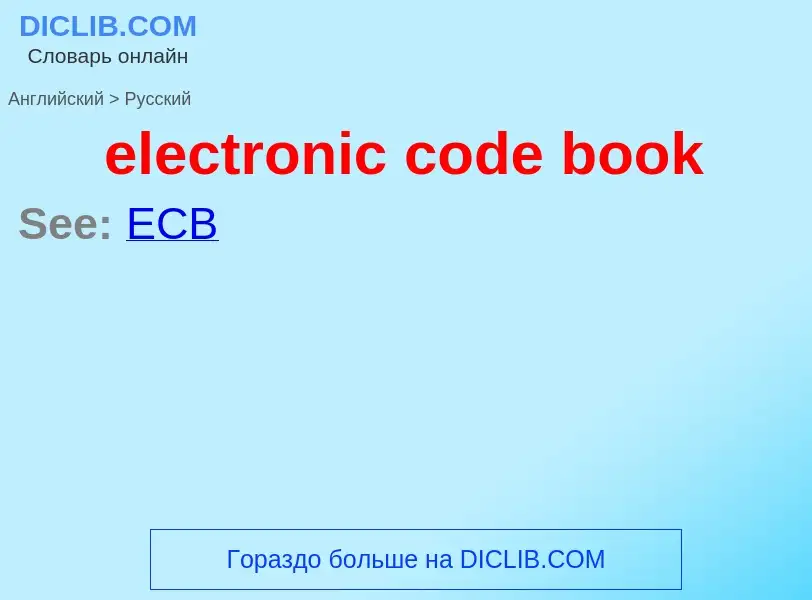Перевод и анализ слов искусственным интеллектом ChatGPT
На этой странице Вы можете получить подробный анализ слова или словосочетания, произведенный с помощью лучшей на сегодняшний день технологии искусственного интеллекта:
- как употребляется слово
- частота употребления
- используется оно чаще в устной или письменной речи
- варианты перевода слова
- примеры употребления (несколько фраз с переводом)
- этимология
electronic code book - перевод на русский
Смотрите также
общая лексика
electronic book
электронная книга, э-книга
книга в цифровом виде, предназначенная для чтения с помощью специального ПО (Microsoft Reader) и на компьютерах различных видов - настольных, ноутбуках, карманных и др., а также специально предназначенных для этой цели. Книга листается нажатием соответствующих кнопок. Текст можно читать на подсвечиваемом дисплее компьютера в течение срока работы батареи или аккумулятора. Поскольку этот сегмент рынка очень быстро развивается, открытые стандарты на представление электронных книг уже находятся в стадии разработки
Определение
Википедия
In cryptography, a block cipher mode of operation is an algorithm that uses a block cipher to provide information security such as confidentiality or authenticity. A block cipher by itself is only suitable for the secure cryptographic transformation (encryption or decryption) of one fixed-length group of bits called a block. A mode of operation describes how to repeatedly apply a cipher's single-block operation to securely transform amounts of data larger than a block.
Most modes require a unique binary sequence, often called an initialization vector (IV), for each encryption operation. The IV has to be non-repeating and, for some modes, random as well. The initialization vector is used to ensure distinct ciphertexts are produced even when the same plaintext is encrypted multiple times independently with the same key. Block ciphers may be capable of operating on more than one block size, but during transformation the block size is always fixed. Block cipher modes operate on whole blocks and require that the last part of the data be padded to a full block if it is smaller than the current block size. There are, however, modes that do not require padding because they effectively use a block cipher as a stream cipher.
Historically, encryption modes have been studied extensively in regard to their error propagation properties under various scenarios of data modification. Later development regarded integrity protection as an entirely separate cryptographic goal. Some modern modes of operation combine confidentiality and authenticity in an efficient way, and are known as authenticated encryption modes.






![spine]] of the printed book is an important aspect in [[book design]] and of its beauty as an object. spine]] of the printed book is an important aspect in [[book design]] and of its beauty as an object.](https://commons.wikimedia.org/wiki/Special:FilePath/Urval av de bocker som har vunnit Nordiska radets litteraturpris under de 50 ar som priset funnits (2).jpg?width=200)

![A portion of the "[[Zimmermann Telegram]]" as decrypted by [[British Naval Intelligence]] codebreakers. The word ''Arizona'' was not in the German codebook and had therefore to be split into phonetic syllables. A portion of the "[[Zimmermann Telegram]]" as decrypted by [[British Naval Intelligence]] codebreakers. The word ''Arizona'' was not in the German codebook and had therefore to be split into phonetic syllables.](https://commons.wikimedia.org/wiki/Special:FilePath/Ztel2.jpg?width=200)
![The Napoleonic Code in the [[Historical Museum of the Palatinate]] in [[Speyer]] The Napoleonic Code in the [[Historical Museum of the Palatinate]] in [[Speyer]]](https://commons.wikimedia.org/wiki/Special:FilePath/Speyer (DerHexer) 2010-12-19 051.jpg?width=200)


![''Transrational Boog'', 1914, by [[Olga Rozanova]] ''Transrational Boog'', 1914, by [[Olga Rozanova]]](https://commons.wikimedia.org/wiki/Special:FilePath/TransrationalBoog-Rozanova.jpg?width=200)
![[[Zang Tumb Tumb]], 1914, by Marinetti [[Zang Tumb Tumb]], 1914, by Marinetti](https://commons.wikimedia.org/wiki/Special:FilePath/ZangTumbTumb-1914.jpg?width=200)

![Contemporary artist's book by [[Cheri Gaulke]] Contemporary artist's book by [[Cheri Gaulke]]](https://commons.wikimedia.org/wiki/Special:FilePath/Offeringsatthecrossroads.jpg?width=200)

![Title page spread / [[Alexey Parygin]] "Eclipse". Title page spread / [[Alexey Parygin]] "Eclipse".](https://commons.wikimedia.org/wiki/Special:FilePath/Alexey Parygin 2015 Eclipse.jpg?width=200)




